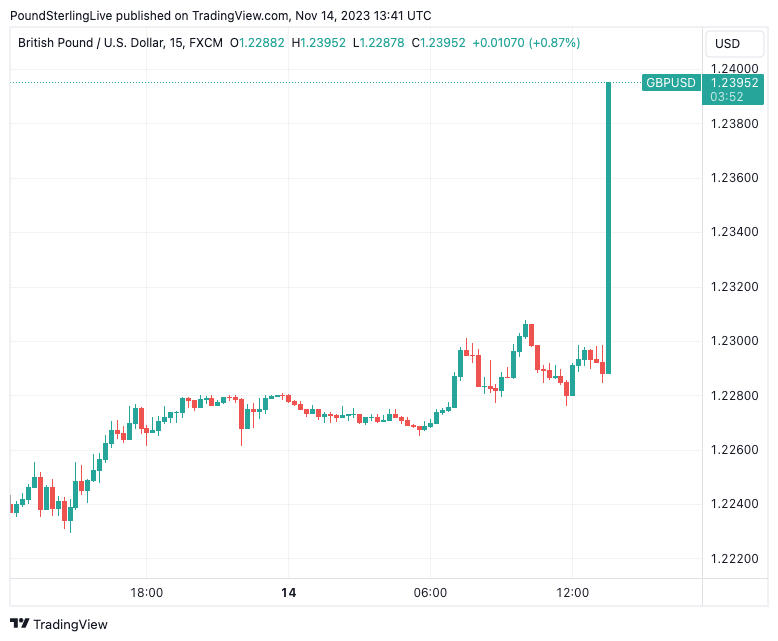GBP/USD Rate At 2-month High Following U.S. Inflation Surprise
- Written by: Gary Howes
-

Image © Adobe Images
The Pound to Dollar exchange rate rose to a two-month high above 1.24 following the release of U.S. inflation data for October that showed inflation in the world's largest economy had softened more than the market was expecting.
The Dollar was sold after official figures showed headline CPI inflation rose 3.2% in the year to October, which was less than the 3.3% figure the market was expecting and represented a sharp slowdown on September's 3.7% reading.
CPI inflation was flat on a month-on-month basis, down on September's energy-infused 0.4% advance and below expectations for 0.1%. The outcome boosts a market narrative that the Federal Reserve has done enough to bring inflation back to the 2.0% target.
Above: GBPUSD at 15-minute intervals showing a sizeable reaction to U.S. inflation figures. Set up a daily rate alert email to track your exchange rate OR set an alert for when your ideal exchange rate is triggered ➡ find out more.
The all-important core CPI inflation figure stood at 4.0% year-on-year in October, below expectations for an unchanged reading of 4.1% from September. Month-on-month core read at 0.2%, down on September's 0.3%, which is also what the market was looking for.
Money market pricing reveals investors now assign less than a 10% chance the Fed will raise interest rates beyond the existing 5.25%-5.50% range. The odds of a further hike by January were as high as 28% ahead of the inflation release, and the market now fully prices the first Fed cut for the June 24 meeting.
U.S. bond yields fell in sympathy, boosting demand for equities and diminishing demand for the Dollar.
"Although core inflation is currently declining only slowly, there are increasing signs this will speed up in early 2024 amidst a softening economic backdrop," says Lindsay James, investment strategist at Quilter Investors. "Today’s inflation data in the US has offered a further signal that the Federal Reserve’s work on interest rates is probably done."
The October inflation numbers reflected falling global oil prices as the energy component printed down 4.5% y/y in October and down 2.5% month on month.
Maintaining upside pressure to the inflation basket were rents, with the shelter component of the CPI basket rising 0.3% m/m.
"The path back down to target is going to be a long and arduous one and may just give the Fed enough cover to ignore the calls for rate cuts for now, no matter how noisy they get," says James.
However, some economists note that service-side inflation has cooled, suggesting consumer demand is softening in response to the higher cost of borrowing and a prolonged period of rising prices. For example, recreation services read at 0.1% m/m, down from 0.5% in September.
The Federal Reserve has been paying particular attention to inflation caused by excess demand as it is sensitive to higher interest rates.
"It wasn’t just the decline in core inflation momentum that prompted this market reaction; the composition of the inflation report was also soft," says Simon Harvey, Head of FX Analysis at Monex Europe.
"For markets, this was the outcome required for traders to resume pricing in earlier and more aggressive rate cuts from the Fed, pick up Treasuries, and sell the dollar into year-end in a similar fashion to late-2022 back when core inflation first started to turn a corner," he adds.












